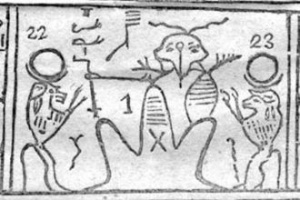Kolob: Difference between revisions
No edit summary |
|||
| Line 11: | Line 11: | ||
In an explanation of an Egyptian hypocephalus that was part of the Joseph Smith Papyri, Smith interpreted one set of hieroglyphics as representing: | In an explanation of an Egyptian hypocephalus that was part of the Joseph Smith Papyri, Smith interpreted one set of hieroglyphics as representing: | ||
"Kolob, signifying the first creation, nearest to the celestial, or the residence of God. First in government, the last pertaining to the measurement of time. The measurement according to celestial time, which celestial time signifies one day to a cubit. One day in Kolob is equal to a thousand years according to the measurement of this earth, which is called by the Egyptians Jah-oh-eh." | "Kolob, signifying the first creation, nearest to the celestial, or the residence of God. First in government, the last pertaining to the measurement of time. The measurement according to celestial time, which celestial time signifies one day to a cubit. One day in Kolob is equal to a thousand years according to the measurement of this earth, which is called by the Egyptians Jah-oh-eh." | ||
The Book of Abraham describes a hierarchy of heavenly bodies, including the Earth, the Moon, and the Sun, each with different movements and measurements of time, where at the pinnacle, the slowest-rotating body is Kolob, where one Kolob-day corresponds to 1000 earth-years. | The Book of Abraham describes a hierarchy of heavenly bodies, including the Earth, the Moon, and the Sun, each with different movements and measurements of time, where at the pinnacle, the slowest-rotating body is Kolob, where one Kolob-day corresponds to 1000 earth-years. This is similar to Psalm 90:4 which says that "For a thousand years in [God's] sight are but as yesterday when it is past" and 2 Peter 3:8 which says, "one day is with the Lord as a thousand years". Additional, similar information about Kolob is found in the Kirtland Egyptian Papers, constituting manuscripts in the handwriting of Smith and his scribes. | ||
==References== | ==References== | ||
Revision as of 18:35, 26 March 2015
Kolob is a star or planet described in Mormon scripture. Reference to Kolob is found in the Book of Abraham, a work that is traditionally held by adherents of the Mormon faith as having been translated from an Egyptian papyrus scroll by Joseph Smith, the founder of the Latter Day Saint movement. According to this work, Kolob is the heavenly body nearest to the throne of God. While the Book of Abraham refers to Kolob as a "star", it also refers to planets as "stars", and therefore, some Mormon commentators consider Kolob to be a planet.The idea also appears in Mormon culture, including a reference to Kolob in a Mormon hymn.[1]
Doctrine and exegesis
Description in the Book of Abraham:Facsimile No. 2 from the Book of Abraham, which Smith said discusses Kolob. The part Smith said refers to Kolob is numbered by a "1" in the center.
The first published reference to Kolob is found in the Book of Abraham, first published in 1842 in Times and Seasons and now included within the Pearl of Great Price as part of the canon of Mormonism. The Book of Abraham was dictated in 1836 by Smith after he purchased a set of Egyptian scrolls that accompanied a mummy exhibition. According to Smith, the scrolls described a vision of Abraham, in which Abraham:
"saw the stars, that they were very great, and that one of them was nearest unto the throne of God; ... and the name of the great one is Kolob, because it is near unto me, for I am the Lord thy God: I have set this one to govern all those which belong to the same order as that upon which thou standest."
In an explanation of an Egyptian hypocephalus that was part of the Joseph Smith Papyri, Smith interpreted one set of hieroglyphics as representing:
"Kolob, signifying the first creation, nearest to the celestial, or the residence of God. First in government, the last pertaining to the measurement of time. The measurement according to celestial time, which celestial time signifies one day to a cubit. One day in Kolob is equal to a thousand years according to the measurement of this earth, which is called by the Egyptians Jah-oh-eh." The Book of Abraham describes a hierarchy of heavenly bodies, including the Earth, the Moon, and the Sun, each with different movements and measurements of time, where at the pinnacle, the slowest-rotating body is Kolob, where one Kolob-day corresponds to 1000 earth-years. This is similar to Psalm 90:4 which says that "For a thousand years in [God's] sight are but as yesterday when it is past" and 2 Peter 3:8 which says, "one day is with the Lord as a thousand years". Additional, similar information about Kolob is found in the Kirtland Egyptian Papers, constituting manuscripts in the handwriting of Smith and his scribes.


